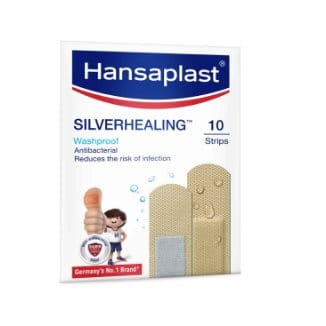Whether it's a sore muscle, a nagging headache, or chronic discomfort, we're all familiar with the pain that comes with it. When this pain strikes, finding an effective and convenient way to manage it becomes a top priority.
One such pain management solution that has gained popularity in recent years is the pain relief patch. These patches offer targeted relief by inducing heat around the injured area. There are many types of pain relief patches available in the market, one of which is natural pain patches.
For those concerned about potential side effects or chemical exposure, natural and herbal ayurvedic pain relief patches have become a preferred choice. In this blog, we'll delve into what pain relief patches are, how they work, and the advantages of opting for natural and herbal options.
Understanding Pain Relief Patches
Pain relief patches are a topical application method for pain management. They are designed to adhere to the skin and deliver active ingredients directly to the affected area. These patches come in various shapes and sizes, allowing for easy application on different body parts.
How Pain Relief Patches Work
The working mechanism of pain relief patches is relatively simple yet highly effective. These patches are infused with active ingredients, which can vary depending on the brand and type of patch. When applied to the skin, the patch slowly releases these active ingredients into the bloodstream, providing localised pain relief.
One common active ingredient found in pain relief patches is menthol, known for its cooling effect. Other patches may contain herbal medications like capsaicin, which can reduce inflammation.
Herbal pain relief patches are particularly beneficial for chronic pain conditions, as they offer sustained relief without the need for frequent dosing. They are discreet and convenient, allowing individuals to continue their daily activities while benefiting from pain relief.
The Advantages of Natural and Herbal Pain Relief Patches
While conventional pain relief patches can be effective, they often contain synthetic chemicals that may come with unwanted side effects or cause concerns about long-term use. Natural and herbal pain relief patches, on the other hand, provide an appealing alternative for those seeking a more holistic approach to pain management. Here are some key advantages of choosing natural and herbal options:
- Reduced Risk of Side Effects:
Natural and herbal pain relief patches are formulated with ingredients derived from plants and herbs. These ingredients are generally considered safe and have been used in traditional medicine for centuries. Compared to synthetic chemicals, they are less likely to cause adverse reactions or side effects, making them a safer choice for individuals with sensitive skin or allergies.
- Non-Toxic Ingredients:
Many conventional pain relief patches contain synthetic chemicals that may not be suitable for everyone. Natural and herbal pain patches, on the other hand, are free from toxic substances like parabens, artificial colours, and preservatives. This makes them a better option for individuals who prefer to avoid exposure to potentially harmful chemicals.
- Minimal Chemical Exposure:
Using natural and herbal pain relief patches minimises the exposure to synthetic chemicals that can accumulate in the body over time. By opting for a more natural approach, individuals can reduce their chemical burden and potentially lower the risk of long-term health issues.
Common Natural Ingredients in Herbal Pain Patches
When exploring the world of natural and herbal pain relief patches, it's essential to understand the ingredients that are commonly used. These ingredients have been chosen for their pain-relieving and soothing properties, making them the foundation of these patches. Here are a few of the most common natural ingredients you might find:
- Capsaicin: Derived from chilli peppers, capsaicin pain plasters are often used to alleviate nerve pain, such as that associated with conditions like arthritis and neuropathy. It works by reducing the intensity of pain signals sent by the nerves.
- Belladonna: This herbaceous plant from the nightshade family has been used in medicine for years. It can aid with back and muscle pain relief. You can also use Belladonna plasters as herbal knee patches for knee pain relief.
- Menthol: Found in mint plants, menthol provides a cooling sensation when applied to the skin. It's commonly used to alleviate muscle and joint pain by temporarily numbing the area and providing a soothing effect.
- Willow Bark: Willow bark contains salicin, which is a natural compound similar to aspirin. It's used for its anti-inflammatory and pain-relieving properties.
- Turmeric: This bright yellow spice contains curcumin, a potent anti-inflammatory and antioxidant compound. Turmeric is known for its ability to reduce joint pain and stiffness, making it a valuable ingredient in herbal patches.
Efficacy and Safety
The effectiveness of natural and herbal pain relief patches is a primary concern for those considering this alternative approach to pain management. Numerous studies and user testimonials suggest that these patches can provide significant relief for various types of pain, including use as a herbal knee patch, for muscle aches or for joint discomfort. The natural ingredients they contain often have well-documented pain-relieving properties.
Moreover, the safety profile of natural and herbal patches is generally excellent. Because these patches utilise ingredients that have been used in traditional medicine for generations, they are less likely to cause adverse reactions or allergic responses. However, it's crucial to follow the manufacturer's instructions and perform a patch test on a small area of skin to ensure compatibility.
Targeted Relief
One of the standout advantages of pain relief patches, whether ayurvedic or traditional, is their ability to provide targeted relief. Unlike oral medications that circulate throughout the entire body, patches can be applied directly to the affected area. This allows for a more localised and concentrated delivery of the active ingredients, enhancing their effectiveness.
Whether you're dealing with a sore shoulder, aching back, or joint pain in your knees, you can choose a specific patch designed to address your particular discomfort. For example, for joint discomfort in the knee, you should apply a herbal knee pain relief patch. This targeted approach minimises the risk of overmedication and allows you to address the pain precisely where it hurts.
Avoiding Harmful Chemicals
Comparing natural and herbal ayurvedic patches to traditional pain relief patches that contain synthetic chemicals is a crucial step in making an informed choice for your pain management needs. Synthetic chemicals in some conventional patches can lead to skin irritation, allergies, or systemic side effects. In contrast, natural and herbal patches prioritise safety by avoiding toxic substances and minimising chemical exposure.
Choosing natural and herbal patches helps you avoid potentially harmful chemicals like artificial colours, fragrances, and preservatives. This not only reduces the risk of immediate side effects but also contributes to your long-term well-being by minimising the accumulation of synthetic compounds in your body.
Takeaway
In conclusion, natural and herbal pain relief patches offer an effective, safe, and targeted solution for managing pain and discomfort. By harnessing the power of natural ingredients like arnica, capsaicin, menthol, willow bark, and turmeric, these patches provide relief without the concerns associated with synthetic chemicals. Whether you're seeking relief from acute or chronic pain, consider exploring the world of natural and herbal pain relief patches to embark on a journey toward holistic pain management and well-being. Remember to consult with a healthcare professional before starting any new pain management regimen, especially if you have underlying medical conditions or are taking other medications.
Disclaimer
Please note that the above recommendations are general care tips. Consult a healthcare professional in case of any uncertainty around wound treatment and healing.
Always see your doctor if a wound is deep, bleeding profusely or showing signs of infection. For diabetic patients especially, proper wound care holds the utmost importance. Do not hesitate to discuss any concerns you may have with your doctor or your podiatrist, even when it comes to minor wounds and cuts–especially if they’re on your feet.
The information provided through this website should not be used to diagnose or treat a health problem or disease. Although compiled with great care, it is not a substitute for professional advice. If you have or suspect a health problem, consult your doctor immediately.
For further information regarding Hansaplast products, please contact us via email at customer.care@bdfindia.com
Medically Reviewed by Dr. Paresh V. Navalkar
A dedicated Regional Faculty member for the American Heart Association, he also takes on the roles of ITLS (USA) Chapter Coordinator and Lead Instructor
Dr Navalkar leads as the Director of the Lifesupporters Institute of Health Sciences in Mumbai, with an impressive 39-year track record of professional experience.



